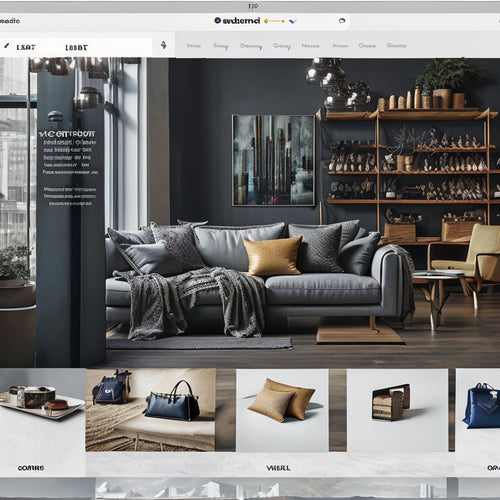
Shopify Australia: Ecommerce Insights and Marketing Trends
Share
The Australian ecommerce market is booming, with a projected value of AU$43.8 billion by 2025, driven by consumers' increasing demand for personalized online experiences. To capitalize on this growth, sellers are adopting data-driven marketing strategies, such as influencer collaborations and user-generated content. Mobile commerce is also on the rise, with a focus on seamless user experiences and mobile optimization being essential for conversion rates. As the market continues to evolve, businesses must prioritize customer retention, with strategies like loyalty programs and personalized email campaigns driving revenue growth. With the right approach, Australian ecommerce businesses can reveal their full potential.
Key Takeaways
• The Australian ecommerce market is valued at AU$32.4 billion, growing at a 10.3% year-over-year rate, with projected online sales reaching AU$43.8 billion by 2025.
• Influencer collaborations, user-generated content, and mobile commerce are on the rise, with personalization strategies driving customer loyalty and sustainability gaining importance.
• Optimizing online store performance is critical, with a seamless user experience impacting conversion rates, and mobile optimization, fast site speed, and easy navigation being key.
• Implementing loyalty programs, personalized email campaigns, and excellent customer service can lead to a 25% to 95% revenue increase through repeat customers.
• Shopify's latest developments, including new payment gateways, enhanced security features, and integrated AI tools, position the platform as a leader in the ecommerce space.
Australian Ecommerce Market Overview
As of 2022, Australia's ecommerce market is valued at approximately AU$32.4 billion, driven by a steady growth rate of 10.3% year-over-year, with online sales projected to reach AU$43.8 billion by 2025.
This upward trend is largely attributed to changes in consumer behavior, with more Australians turning to online shopping for convenience and flexibility. A thorough market analysis reveals that consumers are increasingly expecting personalized experiences, with 71% of online shoppers citing personalization as a key factor in their purchasing decisions.
To tap into this growing market, businesses must prioritize understanding consumer behavior and adapt their strategies to meet evolving demands. By doing so, they can capitalize on the immense growth potential of the Australian ecommerce market.
Current Marketing Trends and Insights
With the Australian ecommerce market poised for continued growth, businesses must stay attuned to emerging marketing trends and insights that can inform their strategies and drive success.
To stay ahead of the curve, consider the following key trends:
-
Influencer collaborations and user-generated content are on the rise, offering authentic and relatable marketing opportunities.
-
Mobile commerce continues to grow, making mobile-optimized experiences essential for capturing sales.
-
Personalization strategies are necessary for delivering tailored experiences that drive customer loyalty.
- Sustainability and ethical practices are increasingly important to modern consumers, making it essential to incorporate eco-friendly practices into your business model.
Optimizing Your Online Store Performance
Optimizing your online store's performance is critical to capitalizing on the growing Australian ecommerce market, where a seamless user experience can greatly impact conversion rates and customer loyalty.
To maximize your online store's potential, focus on mobile optimization, as mobile commerce continues to rise in popularity. Guarantee your site is responsive, fast, and easy to navigate, as a slow site can lead to high bounce rates and low conversion rates.
Streamline your checkout process to reduce cart abandonment, and utilize SEO best practices to improve visibility. By implementing these strategies, you can enhance the overall user experience, increase conversion rates, and ultimately drive business growth.
Strategies for Customer Retention Growth
Customer retention is an essential aspect of ecommerce success, as repeat customers drive significant revenue growth, with studies showing that a mere 5% increase in customer retention can lead to a 25% to 95% increase in revenue.
To achieve this, Australian ecommerce businesses can employ various strategies to retain customers. Here are four effective ways to do so:
-
Implement loyalty programs that reward repeat customers and encourage repeat purchases.
-
Send personalized email campaigns based on customer behavior, preferences, and purchase history.
-
Provide excellent customer service to build trust and loyalty with customers.
- Offer exclusive discounts and promotions to existing customers to make them feel valued.
Latest Shopify Platform Developments
Shopify's commitment to innovation is evident in its latest platform developments. The introduction of new payment gateways, enhanced security features, and integrated AI tools provides Australian ecommerce businesses with a competitive edge.
With AI integration, businesses can now harness data insights to inform their marketing strategies and optimize customer experiences. The expansion of payment gateways has broadened the scope for global transactions, making it easier for businesses to tap into international markets.
Moreover, enhanced security features have bolstered trust among customers, ensuring safe and secure transactions. These developments have positioned Shopify as a leader in the ecommerce space, empowering Australian businesses to thrive in an increasingly competitive landscape.
Frequently Asked Questions
How Can I Measure the Success of My Influencer Marketing Campaigns?
"Measure twice, cut once" - to gauge influencer marketing success, track engagement metrics (likes, comments, shares) and conduct ROI analysis to determine campaign effectiveness, ensuring data-driven decisions that drive real results.
What Are the Most Effective Strategies for Reducing Cart Abandonment Rates?
To combat cart abandonment, deploy retargeting campaigns and optimize the checkout process. Offer customer incentives, such as exclusive discounts, and send abandoned cart emails to re-engage customers, resulting in a significant reduction in cart abandonment rates.
Can I Customize My Shopify Store's Design Without Extensive Coding Knowledge?
Investigations reveal that 71% of merchants prefer user-friendly design customization. Fortunately, Shopify offers coding-free themes, empowering merchants to create visually appealing stores without extensive coding knowledge, ensuring a seamless and intuitive design experience.
How Do I Segment My Email List for Targeted and Personalized Campaigns?
To segment your email list, analyze customer demographics, such as age and location, and purchase behavior, including frequency and average order value, to create targeted and personalized campaigns that resonate with specific groups.
What Are the Benefits of Using a Third-Party Logistics Provider With Shopify?
By coincidence, utilizing a third-party logistics provider with Shopify can be a game-changer, producing cost savings and efficiency through streamlined order fulfillment, while scalability and reliability guarantee timely deliveries, resulting in improved customer satisfaction.
Related Posts
-

Why Optimal Pricing Matters for Online Learning Success
You set your online course prices, but ultimately, they set the tone for your students' perception of value, engageme...
-

7 Ways to Measure ROI on Digital Product Downloads
You can measure the ROI of your digital product downloads by tracking sales and revenue growth to identify trends and...
-

Optimize Your Shopify Store With Automated Tagging
This article explores the optimization of Shopify stores through the implementation of automated tagging. Shopify ta...


